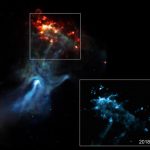Giant ghostly ‘hand’ stretches through space in new X-ray views0
- From Around the Web, Space
- June 29, 2021
An enormous ghostly hand stretches through the depths of space, its wispy fingers pressing against a glowing cloud.

An enormous ghostly hand stretches through the depths of space, its wispy fingers pressing against a glowing cloud.

A stellar structure known as the ‘Hand of God’ is a nebula of energy and particles blown by a pulsar left behind after a star exploded in our Milky Way Galaxy. Otherwise known as MSH 15-52 or G320.4-1.2, the object is located some 17,000 light-years away in the constellation of Circinus. Astronomers estimate that light from the supernova explosion reached Earth about 1,700 years ago, or when the Mayan empire was flourishing and the Jin dynasty ruled China. Previously, astronomers had released a full view of the structure. In a paper in the Astrophysical Journal Letters, they report how quickly the supernova remnant associated with the hand is moving, as it strikes a cloud of gas called RCW 89; the inner edge of this cloud forms a gas wall located about 35 light-years from the center of the explosion.

The center of the Milky Way is a strange and wild place.

A red giant star strayed too close to a supermassive black hole in a galaxy 250 million light-years away.

While observing a large supernova in the ‘Fireworks’ galaxy, researchers accidentally captured imagery of a brief, bright spot in the same galaxy that didn’t originate from the supernova.

The spacecraft launched in July 1999 and has been searching the sky ever since

A new study using data from NASA’s Chandra X-ray Observatory and ESA’s XMM-Newton suggests that dark energy may have varied over cosmic time, as reported in our latest press release.

Black holes, while fascinating, are hardly a new discovery – but a black hole spinning at one of the highest speeds ever, according to the Hindustan Times, is a completely different story – especially when there have only ever been four others like it.

For decades, astronomers have puzzled over the variability of young stars residing in Taurus-Auriga dark clouds, a group of molecular clouds located in the constellations of Taurus and Auriga, about 450 light-years away. Since 1937, they have recorded noticeable dips in the brightness of RW Aur A — the primary star of a low-mass binary system — every few decades. Each dimming event appeared to last for about a month. In 2011, the star dimmed again, this time for about half a year. RW Aur A eventually brightened, only to fade again in mid-2014. In November 2016, the star returned to its full luminosity. Now Hans Moritz Günther of MIT and co-authors have observed RW Aur A using NASA’s Chandra X-Ray Observatory. They’ve found evidence for what may have caused its most recent dimming event: a collision of two protoplanetary bodies, which produced in its aftermath a dense cloud of gas and dust. As this planetary debris fell into RW Aur A, it generated a thick veil, temporarily obscuring the star’s light.

New observations by NASA’s Chandra X-ray Observatory indicate the two brightest stars in the triple-star system Alpha Centauri are not pummeling any orbiting exoplanets with large amounts of X-rays.